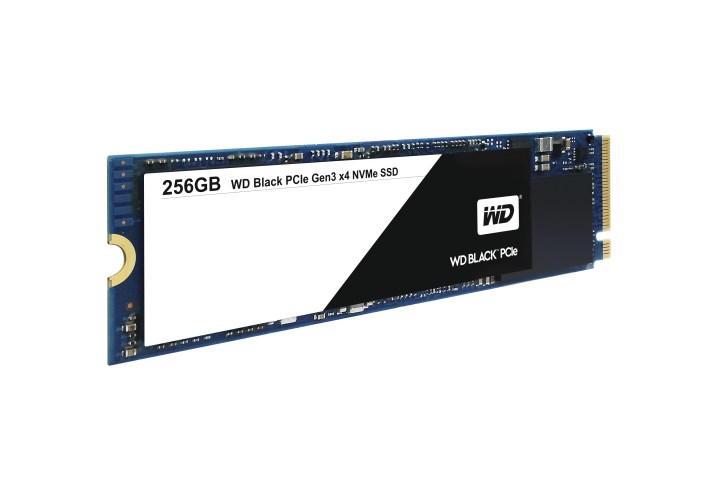
CES 2017 is bringing the usual new product announcements, and storage isn’t being left out. Western Digital has a few new products arriving this year, and they’re covering the bases from a new PCIe SSD drive for fast internal storage, to two new external options for those who need to take their storage on the go.
WD Black PCIe SSD

WD is introducing its first-ever branded client PCIe SSDs at CES 2017, adding to the company’s SSD line that already includes the recently introduced WD Blue and WD Green SATA SSDs. Along with WD’s HDDs, the new WD Black PCIe SSDs round out a full portfolio of PC and workstation storage options.
The WD Black PCIe SSD, which is based on PCIe Gen3 x4 NVMe technology, is up to three times as fast in sequential reads as the company’s SATA-based SSDs. The new drives come in 256GB and 512GB capacities to serve as either fast boot drives in dual drive configurations, or as single drives for notebooks and other systems. The drives will offer 2,050 megabytes per second sequential read performance, and 800MB/s sequential write performance.
The new drives come in 256GB and 512GB capacities.
In terms of reliability, the WD Black PCIe SSD offers 1.75 million hours mean time between failure (MTTF), along with thermal and power management algorithms that exceed the NVMe specifications, to provide more consistent performance and power consumption. WD offers the usual Dashboard software with the WD Black PCIe SSD, to allow users to keep up with the drive’s performance, capacity, and firmware updates.
As Eyal Beck, senior director of SD’s client SSD Devices Business Unit, puts it, “We are in the midst of a once-in-a-generation interface change. The WD Black PCIe SSD ramps up performance while delivering worry-free reliability for our customers worldwide. We believe that this will accelerate the transition that is already occurring from SATA to PCIe. Western Digital is uniquely positioned to offer customers a complete storage portfolio—HDD or SSD, and SATA or PCIe form factors for every segment of the market.”
Pricing for the WD Black PCIe SSD will range from $109 for the 256GB version, to $200 for the 512GB version. Both will come with five-year limited warranties and will be available sometime during the first half of 2017.
SanDisk Extreme Pro USB 3.1 SSD

WD’s SanDisk division is introducing what the company calls its fastest USB flash drive in the Extreme Pro USB 3.1 SSD. SanDisk is positioning the 256GB drive as offering true SSD-class performance in an external drive that will be ideal for anyone who creates and transports large files.
The Extreme Pro USB 3.1 SSD offers read performance of up to 420 megabytes per second reads, and write speeds of up to 380MBs. That’s good enough to transfer a full-length 4K movie in less than 15 seconds, according to SanDisk. The USB 3.1 interface provides the interface speed necessary to simply plug in the drive and start working without fussing with a cable.
Sven Rathjen, VP of marketing for WD’s Client Solutions Business Unit, describes the new flash drive. “The combination of SSD performance and a compact USB form factor offers the ultimate performance and convenience for moving files easily and quickly. With its increased capacity and blazing speeds, the SanDisk Extreme PRO USB 3.1 Solid State Flash Drive is our sleekest, most powerful SanDisk USB device yet.”
The 256GB SanDisk Extreme Pro USB 3.1 SSD will be available later in January 2017 at Amazon and Best Buy, for $180. It also comes with SanDisk SecureAccess software for 128-bit file encryption and password protection, and an aggressive limited lifetime warranty.
SanDisk 256 Ultra microSD card with A1

SanDisk is also pushing the performance envelope with the new 256GB Ultra microSD card, the world’s first to meet the Application Performing Class 1 (A1) requirements based on the SD Association’s SD 5.1 specifications. The A1 spec is defined as providing random read input-output access per second (IOPS) of 1,500 and write IOPS of 500, meaning that the new card is capable of switching tasks and opening apps quickly and efficiently.
The new 256 Ultra microSD card can transfer data at up to 95 megabytes per second.
As Brian Kumagai, SDA president, puts it, “SD technology is trusted by consumers around the world for its reliable, backward-compatible and highly interoperable storage, making it the world’s leading memory format with billions of SD memory cards and devices in the market. The A1 specification will help consumers identify the appropriate card to ensure an optimal experience when running and launching apps on their smartphone. We are pleased that SanDisk will release an A1 card, and continues to contribute to breakthrough technologies enabled by the microSD format.”
In terms of throughput, the new 256 Ultra microSD card can transfer data at up to 95 megabytes per second, and it’s compatible with SanDisk’s Memory Zone app for Android, which lets users easily manage and back up contents. The card will be available in January 2017 for $200.


